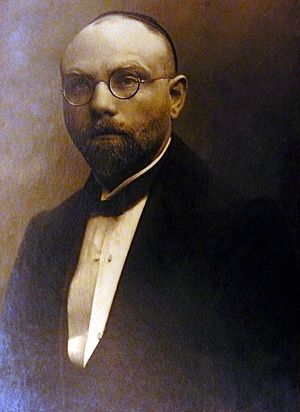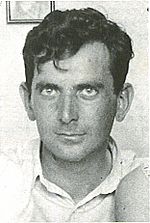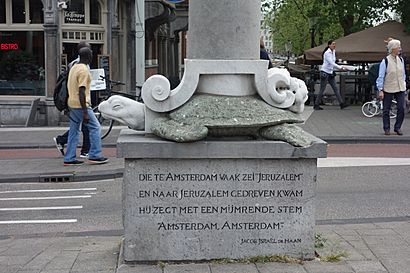Jacob Israël de Haan facts for kids
Jacob Israël de Haan (born December 31, 1881 – died June 30, 1924) was a Dutch Jewish writer, lawyer, and journalist. He moved to Palestine in 1919. In 1924, he was killed in Jerusalem by a group called the Haganah. This happened because of his political actions against Zionism, which was a movement to create a Jewish state.
Quick facts for kids
Jacob Israël de Haan
|
|
|---|---|

Jacob Israël de Haan
|
|
| Cause of death | Gunshot wound |
| Occupation | Writer, Journalist, Lawyer |
Contents
Early Life and Education
Jacob Israël de Haan was born in Smilde, a village in the northern part of the Netherlands. He grew up in Zaandam. He was one of many children in his family, and he received a traditional Jewish education.
In 1904, while living in Amsterdam, he wrote a novel called Pijpelijntjes. This book caused a scandal at the time. To try and stop the controversy, his fiancée, Johanna van Maarseveen, and a friend bought almost all the copies of the book. In 1907, he married Johanna van Maarseveen, who was a doctor. They separated in 1919 but never officially divorced.
Helping Prisoners in Russia
In 1912, Jacob de Haan traveled to Russia. He visited many prisons to learn about the conditions for political prisoners. He wrote about his findings in a book called "In Russian Prisons" (1913).
He also started a committee with other Dutch writers. Their goal was to gather signatures. They wanted countries like France and Great Britain to pressure Russia to treat prisoners better. Because of this work, some people have called him an early supporter of human rights, similar to groups like Amnesty International.
Moving to Palestine
Interest in Zionism
Around 1910, Jacob de Haan became interested in the Land of Israel and Zionism. Zionism is a movement that supports the creation and development of a Jewish state in the historical Land of Israel. His interest grew after he worked to help Jewish prisoners in Russia. This made him very aware of the dangers of anti-Semitism, which is prejudice against Jewish people.
Becoming a Religious and Anti-Zionist Voice
De Haan wrote a lot about the Land of Israel even before he moved there in 1919. He settled in Jerusalem. He taught at a new law school and sent articles to important Dutch newspapers.
After moving to Jerusalem, De Haan became more dedicated to his religious beliefs. He was upset that some Zionist groups did not want to work with Arab leaders.
At first, he supported a type of Zionism that was connected to religious beliefs. But after meeting Rabbi Yosef Chaim Sonnenfeld, a leader of the very traditional Haredi Jewish community, De Haan became their political spokesperson. He was chosen as the political secretary for the Orthodox community council. De Haan tried to make an agreement with Arab leaders. He hoped they would allow Jewish people to move to Palestine freely. In return, he wanted Jewish leaders to give up on the Balfour Declaration, which supported a Jewish homeland in Palestine.
The mainstream Zionist leaders did not allow the Haredi community to be part of the Jewish Agency for Israel in the 1920s. So, the Haredim created their own political group in Jerusalem to represent their interests. Rabbi Yosef Chaim Sonnenfeld chose De Haan to organize and speak for the Haredi community on a diplomatic level.
De Haan even disagreed with the British authorities when they offered separate benefits to the Zionist-led Jewish community.
In 1923, De Haan met with Arab leaders in Amman. He spoke with Emir Hussein bin Ali, Sharif of Mecca and his son, Abdullah I of Jordan. He explained the Haredi Jewish community's opposition to the Zionist plans for a state. He supported the idea of an official Palestinian state as part of a larger federation. De Haan planned to travel to London in July 1924 with a Haredi group to speak against Zionism.
Assassination
Jacob Israël de Haan was about to leave for London when he was killed in Jerusalem on June 30, 1924. He was leaving the synagogue at the Shaare Zedek Hospital. A member of the Haganah, named Avraham Tehomi, approached him. Tehomi shot him three times and then ran away. De Haan died shortly after.
At first, many people in the Jewish community in Palestine believed that Arabs were responsible for the killing. They trusted the Zionist leaders who said they had no part in it. But over time, doubts grew. Finally, in 1952, Yosef Hecht, the first commander of the Haganah, explained what happened. Hecht said that to stop De Haan's planned trip to London, he discussed the issue with the Haganah commander in Jerusalem. They decided to kill him. Two Haganah members were chosen for the task. Hecht only told the civilian leaders after the assassination. He said he did not regret it.
A book published in 1985, De Haan: The first political assassination in Palestine, brought more attention to his death. The authors found Tehomi, who was living in Hong Kong. Tehomi was interviewed and said that Yitzhak Ben-Zvi, who later became the second President of Israel, must have ordered the assassination. Tehomi stated, "I have done what the Haganah decided had to be done. And nothing was done without the order of Yitzhak Ben-Zvi... I have no regrets because he (De Haan) wanted to destroy our whole idea of Zionism."
Aftermath and Remembrance
De Haan was buried on the Mount of Olives. Hundreds of Haredi Jews, along with Zionist and British officials, attended his funeral. After the funeral, some Haredi Jews went into the city center to confront Zionists. The police had to step in to stop them.
The British government in Palestine sent condolences to the Agudath Israel headquarters. Other countries also sent messages. In New York, some very traditional Jewish people praised De Haan. They criticized "Zionists, who use violence." The British authorities offered a reward for information about the killer, but Tehomi was never caught.
De Haan's murder shocked people in Palestine and Europe. Important Zionist leaders blamed each other. Many people wondered who the killer was.
De Haan's murder is seen as the first political killing in the Jewish community in Palestine. His actions were thought to be against the goal of creating a Jewish state. However, the assassination caused a lot of debate, and some people strongly condemned it.
German author Arnold Zweig wrote a book in 1932 based on De Haan's life. Israeli writer Haim Beer's book "Notzot" (1979) also has a character inspired by De Haan.
Some very traditional Jewish groups, like Neturei Karta, see De Haan as a hero. They believe he was killed by secular Jews while protecting the Jewish religion. However, most Haredi Jews do not agree with all of his views.
In the Netherlands
Even though De Haan's fame lessened after his death, his writings have been published again. During the Nazi occupation of the Netherlands, his "Letters from Jerusalem" were published. In 1949, a group was formed to publish all of his poems. A "Society Jacob Israël de Haan" helped publish more of his works, including his philosophical ideas and letters.
In the 1970s, there was a new interest in De Haan's work. Many of his writings about law were reprinted. His novels and earlier prose were also republished. Many articles and books were written about his life, leading to lively discussions. A large collection of his letters was published in 1994.
Over the years, there have been projects, festivals, and theater shows in the Netherlands to remember Jacob Israël de Haan's work and life. A line from one of his poems is carved into a sculpture in Amsterdam. It reads: "For friendship such a limitless longing..."
See also
 In Spanish: Jacob Israël de Haan para niños
In Spanish: Jacob Israël de Haan para niños
- Edah HaChareidis
- History of the Jews in the Netherlands
- Zionist political violence



